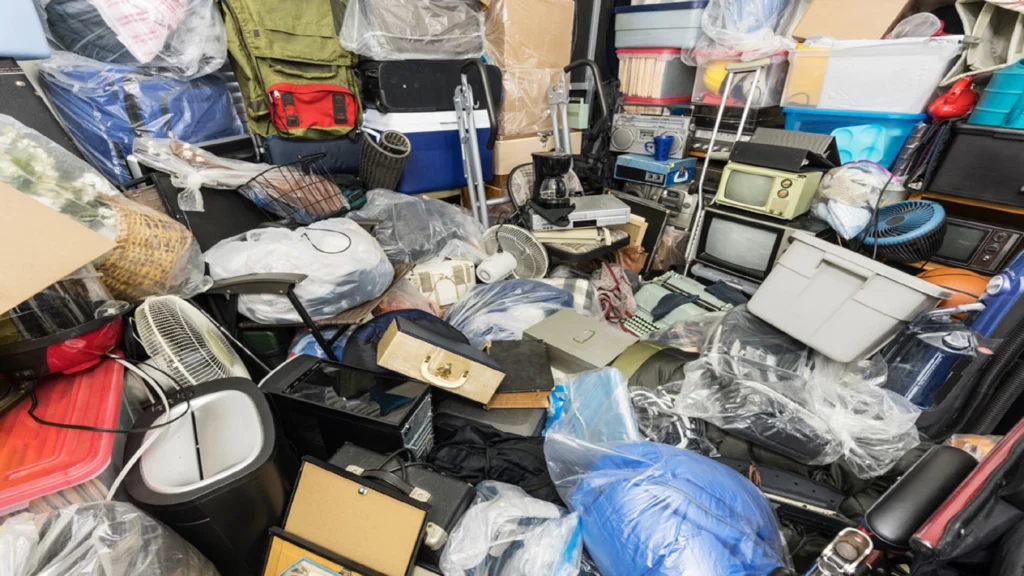Help a hoarder clean their house by offering emotional support and creating a step-by-step decluttering plan. Prioritize safety and health during the process.
Hoarding can be a sensitive and overwhelming issue, both for the person affected and their loved ones. It is crucial to approach the situation with empathy and patience. Start by having an open and honest conversation about the problem. Offer your support and assure them that they are not alone.
Create a structured plan that breaks down the cleaning process into manageable steps. Focus on one room or area at a time to avoid overwhelming the person. Remember to prioritize safety and health by wearing protective gear and ensuring proper disposal of hazardous items. Seeking professional help can also be beneficial in severe cases.
Recognizing Hoarding Behavior
Help a hoarder clean their house can be a challenging task. Recognizing hoarding behavior is the first step in offering effective support. Hoarding is not just about collecting things; it often involves emotional, financial and psychological struggles. Understanding these aspects can make the process smoother and more compassionate.
Signs Of Hoarding
Recognizing the signs of hoarding is crucial. There are several indicators that someone might be struggling with hoarding behavior:
- Excessive accumulation of items that seem useless
- Inability to discard possessions, regardless of their value
- Cluttered living spaces that are difficult to use for their intended purposes
- Emotional attachment to items, often linked to memories or perceived utility
People who hoard often feel overwhelmed. They may feel ashamed or embarrassed by their situation. This emotional burden makes it hard for them to seek help. A cluttered home might have narrow pathways and blocked exits. Such conditions can pose serious safety risks. Fire hazards and health issues are common in hoarded home.
Hoarding can also lead to social isolation. The person may avoid having guests over. This can strain relationships with family and friends.
Emotional Triggers
Various emotional triggers can lead to hoarding behavior. Understanding these triggers can help in addressing the root cause of the problem:
- Anxiety and stress can make hoarding worse. The person might hoard to feel safe.
- Depression often accompanies hoarding. The clutter can make the person feel hopeless.
- Grief or loss might trigger hoarding. Holding onto items can serve as a comfort.
Help a hoarder involves addressing these emotional triggers. Creating a supportive environment is key. Encourage open communication and listen without judgment. Professional help can be beneficial. Therapists and counselors can offer strategies to cope with anxiety and depression. Support groups can also provide a sense of community and understanding.
Patience is essential. Hoarding is a complex issue that won’t be resolved overnight. Celebrate small victories and progress to keep motivation high.
Preparing For The Cleanout
Helping a hoarder cleanout their house can be a challenging task. It requires patience, empathy, and a well-thought-out approach. Hoarding is more than just collecting items; it’s a disorder that can significantly impact a person’s life. Preparing for the clean-out is a crucial first step. This involves setting clear goals and creating a detailed plan to make the process as smooth as possible.
Setting Goals
Before starting the hoarder cleanout, it’s important to set clear goals. This helps to keep everyone focused and motivated. Goals should be realistic and achievable. They can include:
- Decluttering specific areas: Focus on one room or area at a time.
- Sorting items: Decide what to keep, donate, or throw away.
- Improving safety: Make pathways clear and remove hazards.
It’s also helpful to set a timeline for each goal. This keeps the process moving forward and prevents it from becoming overwhelming. For example:
| Goal | Timeline |
| Declutter the living room | 1 week |
| Sort kitchen items | 3 days |
| Clear pathways | 2 days |
Involving the hoarder in setting these goals is crucial. It gives them a sense of control and ownership over the process. This can make them more cooperative and willing to participate in the clean-out.
Creating A Plan
Once goals are set, creating a detailed plan is the next step. A good plan outlines the steps needed to achieve each goal. This includes:
- Gathering supplies: Boxes, trash bags, gloves, and cleaning products.
- Allocating time: Schedule specific days and times for cleaning sessions.
- Enlisting help: Friends, family, or professional organizers can provide support.
Breaking down tasks into smaller, manageable steps makes the process less daunting. For example:
- Start with a small area like a drawer or a shelf.
- Sort items into categories: keep, donate, and trash.
- Clean the area before moving on to the next task.
Regular breaks are also important. Cleaning can be physically and emotionally exhausting. Taking time to rest helps maintain energy and motivation. Encouragement and positive reinforcement can make a big difference. Celebrate small victories to keep spirits high. This approach ensures steady progress and helps avoid burnout.
Starting The Process
Helping a hoarder cleanout their house can be a challenging yet rewarding task. Starting the process requires patience, understanding, and a solid plan. The steps outlined in this guide can help make the process smoother and more effective.
Choosing A Room
Choosing the right room to start with is crucial. Begin with a smaller room or a less cluttered area. This can make the task feel less overwhelming. A bathroom or a hallway closet can be a good starting point.
Here are some tips to help you choose the right room:
- Pick a room that is less emotional for the hoarder.
- Avoid starting with a room that has sentimental items.
- Consider the amount of clutter and start small.
Starting with a manageable space can build confidence. Success in one room can motivate tackling larger areas. Always keep the hoarder’s feelings in mind when choosing a room.
Sorting Items
Sorting items is a critical step in the cleaning process. Use three categories: Keep, Donate, and Trash. This helps in organizing the clutter systematically.
Here is a simple way to sort items:
| Category | Description |
| Keep | Items that are necessary and used regularly. |
| Donate | Items in good condition that can help others. |
| Trash | Items that are broken or no longer useful. |
Work with the hoarder to decide which items fit into each category. Be patient and respectful of their decisions. This can be an emotional process for them.
Encourage the hoarder to take small steps. Sorting a few items at a time can be less stressful. Celebrate small victories to keep the momentum going. This can lead to a more organized and clutter-free space.
Emotional Support Strategies
Help a hoarder clean their house is a challenging task. It requires patience, empathy, and strong emotional support strategies. Hoarding can be overwhelming for the person dealing with it. Offering emotional support is crucial. This can help them feel understood and less alone. Let’s explore some effective emotional support strategies for helping a hoarder.
Building Trust
Building trust is the first step in help a hoarder. Trust is essential to make them feel safe and supported. Speak to them with kindness and empathy. Avoid harsh words or judgments. Show that you are there to help, not to criticize.
Here are some ways to build trust:
- Listen without interrupting.
- Acknowledge their feelings.
- Reassure them that their feelings are valid.
Use encouraging words and be consistent in your support. Consistency helps in building a strong foundation of trust. This trust will make it easier for them to accept help.
Here is a simple table summarizing key actions:
| Action | Benefit |
| Listening | Helps them feel heard |
| Acknowledging feelings | Validates their emotions |
| Reassuring | Builds confidence in you |
Encouraging Small Wins
Encouraging small wins can make a big difference. Start with easy tasks that can be completed quickly. This will help them feel a sense of accomplishment. Small wins can motivate them to tackle bigger tasks.
Break down the cleaning process into manageable steps. For example:
- Clear one drawer at a time.
- Organize a single shelf.
- Sort through a small box of items.
Celebrate each small win to boost their morale. Positive reinforcement is key. Compliment their efforts and progress. This will encourage them to keep going.
Here is a simple way to track small wins:
| Task | Status |
| Clear one drawer | Completed |
| Organize a shelf | In Progress |
| Sort through a box | Not Started |
Tracking progress helps them see their achievements. It keeps them motivated. Remember, each small win is a step towards a cleaner, healthier home.
Maintaining A Clutter-free Space
Helping a hoarder cleanout their house can be challenging, but it’s essential for their well-being. Maintaining a clutter-free space is vital for mental and physical health. Help a hoarder requires patience, understanding, and practical steps to create a livable environment. This guide will provide strategies to keep spaces tidy and healthy.
Establishing Routines
Creating routines is crucial for maintaining a clutter-free home. Routines help develop habits that reduce the buildup of unnecessary items. Start with small, manageable tasks to avoid overwhelming the hoarder.
Daily Decluttering:
- Set aside 15 minutes each day for cleaning.
- Focus on one small area at a time.
- Encourage the person to dispose of or donate one item daily.
Weekly Tasks:
- Organize a different room each week.
- Use storage solutions like bins and shelves.
- Label items to make them easy to find.
Monthly Check-ins:
- Review progress and adjust routines as needed.
- Celebrate achievements, no matter how small.
- Set new goals for continued improvement.
Seeking Professional Help
Hoarding can be complex, and seeking professional help can make a significant difference. Professionals provide the necessary support and tools to address the underlying issues of hoarding. They offer expert guidance and support throughout the process.
Benefits of Professional Help:
- Therapists help address the emotional aspects of hoarding.
- Professional organizers provide practical decluttering strategies.
- Support groups offer a sense of community and shared experiences.
Types of Professionals:
| Professional | Role |
| Therapist | Addresses underlying emotional issues. |
| Professional Organizer | Helps create a manageable plan for decluttering. |
| Support Group | Provides peer support and encouragement. |
Combining professional help with established routines offers the best chance for a hoarder to maintain a clutter-free space. This approach ensures long-term success and a healthier living environment.
Conclusion
Helping a hoarder cleanouts their house requires patience and empathy. Celebrate small victories along the way. Stay supportive, and always encourage professional help if needed. Your compassion and dedication can make a significant difference in their life. Together, you can create a healthier, clutter-free environment.







